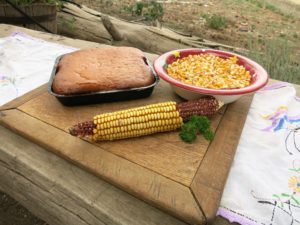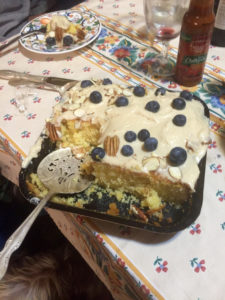 “The North thinks it knows how to make cornbread, but this is gross superstition.”
“The North thinks it knows how to make cornbread, but this is gross superstition.”
— Mark Twain
My editor recently observed that I hadn’t written about corn in a while. He recognizes I’m obsessed with that commonest of vegetables. As the buffalo was to the Sioux prairie dwellers, so corn was to my ancestral culture. My forefathers hacked clearings in the great primeval forests of Tennessee and Kentucky and planted patches of corn and beans and squash. Fresh “roasting ears” were cooked in their husks in the hot ashes of the fireplace. They carried their grain to a water-powered grist mill that ground the corn between stone burrs. They left a toll of ground meal in payment. A batter of meal, water, salt and bacon grease produced a hearty pone that was nutritious and tasty and a staple of their diet. The whole kernels were sprouted and fermented and then distilled into a potent moonshine.
 One of my earliest memories is of following behind Daddy’s tractor, walking in the raw furrow, the sandy soil cool on my bare feet. Sometimes the plow exposed a fierce hognose snake or an arrowhead or metate that hadn’t seen sunlight for 1,000 years. I participated in the magic of dropping yellow grains of corn in the soil and covering them with a hoe.
One of my earliest memories is of following behind Daddy’s tractor, walking in the raw furrow, the sandy soil cool on my bare feet. Sometimes the plow exposed a fierce hognose snake or an arrowhead or metate that hadn’t seen sunlight for 1,000 years. I participated in the magic of dropping yellow grains of corn in the soil and covering them with a hoe.
Daddy ground the corn we grew in a stone burr mill driven by the power take off of the tractor. The hot stones released an intoxicating odor of toasted grain. He ground the year’s supply of mill in one day. Mama’s cornbread was present at all meals, sometimes even breakfast. She served it up hot with soup beans or black-eyed peas or crumbled into a bowl of milk. Sometimes she cooked it up for pancakes and drizzled them with molasses syrup. Mama made a very basic hearty bread in the cast iron skillet. It was robust and nutty. She didn’t usually have the niceties of eggs or milk and wouldn’t have dreamed of adding sugar. She baked in a seasoned cast iron skillet which imparted its own flavor and texture. It was literally the staff of our life and I found it delicious in all its permutations.
I was shopping in a local health food establishment recently when I decided to take my lunch in the hot food section. Bright colored vegetables and seductive fruits were all around me as I ladled up a bowl of savory chili. I looked about for crackers and I was delighted to see a fresh baked loaf labeled Traditional Cornbread.
I cut a slice of the Traditional Cornbread and bit into a sweet gummy yellow cake. Shocked I looked at the label. There were fourteen ingredients not counting the additives that enriched its main ingredient: wheat flour. Corn meal didn’t appear until seventh place after sugar, water and soybean oil. Whose tradition was this? I researched the history of cornbread and I learned that sugar and wheat flour began to make an appearance in cornbread recipes after the practice of stone milling was replaced by roller mills that separated out the germ. The germ contained the oil and much of the rich flavor. The rollers produced a finer flour-like particle that did not cook up like stone ground meal. A slippery slope was entered as people began to add sugar and wheat flour to replace the natural sweetness and proper consistency they were accustomed to.
I was inspired to recreate the cornbread of my youth. I put several cups of whole grain corn into the hopper of my Magic Mill, a prize I found at a thrift store which has stone burrs and adjustable fineness of grind. My wife had grown the yellow dent corn in her garden patch where it soaked up the cinder rich soil and southern exposure to the sun. Sinagua Indians once grew their beans and corn there. She placed the husk wrapped ears in our small greenhouse to thoroughly dry. She checked one day to find that the ground squirrels had taken half of it. I adjusted the grist to a coarser texture than we used for our wheat flour.
This is the recipe I used:
Preheat oven to 425°. Heat seasoned cast iron skillet with 1 tablespoon oil until smoking. Transfer to a burner on stove to keep hot.—
2 cups cornmeal
½ teaspoon salt
½ teaspoon baking powder
½ teaspoon baking soda
1½ cups buttermilk
1 egg, beaten
5 tablespoons oil [I used coconut oil. Safflower, bacon grease or corn oil is OK, but butter or olive oil burn too easily.]
Mix dry ingredients. Mix milk and egg and stir in 4 tablespoons oil then stir into dry ingredients—don’t over stir. Spoon into hot skillet and then bake 20–25 minutes or until knife stuck in the middle comes out clean.
The result was a firm golden loaf with a great toasty aroma and a nice crunchy crust. I ate a piece hot with butter. Yes. I served myself a bowl of soup beans made from the mayacoba beans, the choice of Mexicans over pintos for creamy mild frijoles. The texture of the bread was firm with a nice crumb and the tang of the buttermilk added richness. I guess you can go home.
What to do with the Traditional Cornbread? We were having company for dinner that night. I spread frosting on top of the sugary yellow slab and studded it with blueberries and sliced almonds. Everyone agreed it was a tasty dessert, though some found it a little too sweet.

